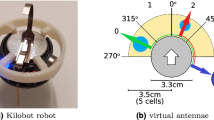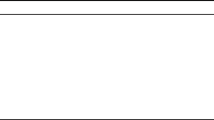Abstract
In this work, we propose a swarm algorithm with tendencies of repulsion, attraction, and influence for implementation in a pack of autonomous robots and with sensory limitations. The pack of robots performs an object transport task with a foraging approach; each object is distributed within a foraging zone and has to be transported to a specific destination (nest). The main challenge involves solving several important subtasks: search, navigation, transportation, localization and harvesting; which are associated with different stimuli in the environment. The main contribution is that the RAOI approach is extended, proposing multiple influence stimuli that are activated in a finite state machine, which is implemented in each individual without affecting swarm decentralized properties. From this extended RAOI scheme, the task performance has been improved by changing robot parameters; for this, the results are quantified with task execution time and are validated through simulations and implementations.

















Similar content being viewed by others
References
Baxter, G. W. (2009). The dynamics of foraging ants. In APS March meeting abstracts, APS meeting abstracts, p. H40.011.
Bayındır, L. (2016). A review of swarm robotics tasks. Neurocomputing, 172, 292–321.
Beni, G. (2005). From swarm intelligence to swarm robotics. In E. Şahin & W. M. Spears (Eds.), Swarm robotics (pp. 1–9). Berlin: Springer.
Brambilla, M., Ferrante, E., Birattari, M., & Dorigo, M. (2013). Swarm robotics: A review from the swarm engineering perspective. Swarm Intelligence, 7(1), 1–41. https://doi.org/10.1007/s11721-012-0075-2
Couzin, I. D., Krause, J., James, R., Ruxton, G. D., & Franks, N. R. (2002). Collective memory and spatial sorting in animal groups. Journal of Theoretical Biology, 218, 1–11. https://doi.org/10.1006/yjtbi.3065
Deneubourg, J. L., Goss, S., Franks, N., Sendova-Franks, A., Detrain, C., & Chrétien, L. (1991). The dynamics of collective sorting robot-like ants and ant-like robots. In Proceedings of the first international conference on simulation of adaptive behavior on from animals to animats (pp. 356–363). MIT Press.
Dixon, W. (2006). Control of robot manipulators in joint space, r. kelly, v. santibáñez and a. loria, Springer, London, U.K., 2005, 426pp. ISBN: 1-85233-994-2. International Journal of Robust and Nonlinear Control, 16, 945–946. https://doi.org/10.1002/rnc.1114
Efremov, M., & Kholod, I. (2020). Swarm robotics foraging approaches. In 2020 IEEE conference of Russian young researchers in electrical and electronic engineering (EIConRus) (pp. 299–304). https://doi.org/10.1109/EIConRus49466.2020.9039340
Erusagounder, S., Senthilkumar, G., Prithiviraj, K., & Devraj, K. (2018). Foraging behavior analysis of swarm robotics system. In MATEC web of conferences (Vol. 144, p. 01013). https://doi.org/10.1051/matecconf/201814401013
Filipović, V., Nedic, N., & Stojanovic, V. (2011). Robust identification of pneumatic servo actuators in the real situations. Forschung im Ingenieurwesen. https://doi.org/10.1007/s10010-011-0144-5
Fong, S., Deb, S., & Chaudhary, A. (2015). A review of metaheuristics in robotics. Computers & Electrical Engineering, 43, 278–291.
Garattoni, L., & Birattari, M. (2016). Swarm robotics (pp. 1–19). American Cancer Society. https://doi.org/10.1002/047134608X.W8312
Gauci, M., Chen, J., Li, W., Dodd, T. J., & Gross, R. (2014). Clustering objects with robots that do not compute. In Proceedings of the 2014 international conference on autonomous agents and multi-agent systems, AAMAS ’14 (pp. 421–428). International Foundation for Autonomous Agents and Multiagent Systems, Richland, SC.
Gerling, V., & Von Mammen, S. (2016). Robotics for self-organised construction. In 2016 IEEE 1st international workshops on foundations and applications of self* systems (FAS*W) (pp. 162–167).
Hamann, H. (2018). Swarm robotics: A formal approach. New York: Springer.
Hansell, M. (2008). Built by animals: The natural history of animal architecture. Oxford: Oxford University Press.
Holland, O., & Melhuish, C. (1999). Stigmergy, self-organization, and sorting in collective robotics. Artificial Life, 5(2), 173–202. https://doi.org/10.1162/106454699568737
Jevtić, A., & Andina de la Fuente, D. (2007). Swarm intelligence and its applications in swarm robotics. In Proceedings of the WSEAS international conferences : 6th WSEAS International Conference on Computational Intelligence, Man-Machine Systems and Cybernetics. http://oa.upm.es/1947/
Khaldi, B., & Cherif, F. (2015). An overview of swarm robotics: Swarm intelligence applied to multi-robotics. International Journal of Computer Applications, 126(2), 31–37.
Khalil, H. (1996). Nonlinear systems. Hoboken: Prentice Hall.
Khaluf, Y. (2016). Adaptive construction behavior in robot swarms. In Proceedings of the eighth international conference on adaptive and self-adaptive systems and applications (pp. 34–39).
Khoshnevis, B. (2004). Automated construction by contour crafting—Related robotics and information technologies. Automation in Construction, 13(1), 5–19.
Lu, Q., Fricke, G. M., Ericksen, J. C., & Moses, M. E. (2020). Swarm foraging review: Closing the gap between proof and practice. Current Robotics Reports, 1, 1–11.
Márquez-Vega, L. A., Aguilera-Ruiz, M., & Torres-Treviño, L. M. (2019). Multi-objective optimization of a quadrotor flock performing target zone search. Swarm and Evolutionary Computation, 60, 100733.
Martinoli, A., & Mondada, F. (1997). Collective and cooperative group behaviours: Biologically inspired experiments in robotics. In O. Khatib & J. K. Salisbury (Eds.), Experimental robotics IV (pp. 1–10). Berlin: Springer.
Ordaz-Rivas, E., Rodriguez-Liñan, A., Aguilera-Ruíz, M., & Torres-Treviño, L. (2018). Collective tasks for a flock of robots using influence factor. Journal of Intelligent & Robotic Systems. https://doi.org/10.1007/s10846-018-0941-2
Petersen, K. H., Napp, N., Stuart-Smith, R., Rus, D., & Kovac, M. (2019). A review of collective robotic construction. Science Robotics. https://doi.org/10.1126/scirobotics.aau8479
Resnick, M. (1997). Turtles, termites, and traffic jams: Explorations in massively parallel microworlds. Cambridge: Mit Press.
Reynolds, C. W. (1987). Flocks, herds and schools: A distributed behavioral model. SIGGRAPH Computer Graphics, 21(4), 25–34. https://doi.org/10.1145/37402.37406.
Şahin, E. (2005). Swarm robotics: From sources of inspiration to domains of application. In E. Şahin & W. M. Spears (Eds.), Swarm robotics (pp. 10–20). Berlin: Springer.
Scheidler, A., Merkle, D., & Middendorf, M. (2013). Swarm controlled emergence for ant clustering. International Journal of Intelligent Computing and Cybernetics, 6, 62–82. https://doi.org/10.1108/17563781311301526
Schranz, M., Umlauft, M., Sende, M., & Elmenreich, W. (2020). Swarm robotic behaviors and current applications. Frontiers in Robotics and AI. https://doi.org/10.3389/frobt.2020.00036
Shi, Z., Tu, J., Zhang, Q., Liu, L., & Wei, J. (2012). A survey of swarm robotics system. In Y. Tan, Y. Shi, & Z. Ji (Eds.), Advances in swarm intelligence (pp. 564–572). Berlin: Springer.
Sperati, V., Trianni, V., & Nolfi, S. (2011). Self-organised path formation in a swarm of robots. Swarm Intelligence, 5(2), 97–119.
Stojanovic, V., & Filipović, V. (2014). Adaptive input design for identification of output error model with constrained output. Circuits, Systems, and Signal Processing. https://doi.org/10.1007/s00034-013-9633-0
Stojanovic, V., Nedic, N., Prsic, D., & Dubonjic, L. (2016). Optimal experiment design for identification of arx models with constrained output in non-gaussian noise. Applied Mathematical Modelling, 40(13), 6676–6689. https://doi.org/10.1016/j.apm.2016.02.014.
Sugawara, K., & Doi, Y. (2016). Collective construction of dynamic equilibrium structure through interaction of simple robots with semi-active blocks. In N. Y. Chong & Y. J. Cho (Eds.), Distributed autonomous robotic systems (pp. 165–176). Tokyo: Springer Japan.
Tuci, E., Alkilabi, M. H. M., & Akanyeti, O. (2018). Cooperative object transport in multi-robot systems: A review of the state-of-the-art. Frontiers in Robotics and AI, 5, 1–15. https://doi.org/10.3389/frobt.2018.00059
Vardy, A. (2019). Orbital construction: Swarms of simple robots building enclosures. In Proceedings—2018 IEEE 3rd international workshops on foundations and applications of self* systems, FAS*W 2018 (pp. 147–153). https://doi.org/10.1109/FAS-W.2018.00040
Vásárhelyi, G., Virágh, C., Somorjai, G., Nepusz, T., Eiben, A. E., & Vicsek, T. (2018). Optimized flocking of autonomous drones in confined environments. Science Robotics, 3(20). https://doi.org/10.1126/scirobotics.aat3536
Yang, Y., & Kamel, M. (2003). Clustering ensemble using swarm intelligence. In Proceedings of the 2003 IEEE swarm intelligence symposium. SIS’03 (Cat. No. 03EX706) (pp. 65–71). IEEE.
Acknowledgements
Authors are grateful to Consejo Nacional de Ciencia y Tecnología (CONACYT) and Universidad Autónoma de Nuevo León (UANL), for their support and sponsorship with the number of scholarship 334681, for the realization of this project.
Author information
Authors and Affiliations
Corresponding author
Additional information
Publisher's Note
Springer Nature remains neutral with regard to jurisdictional claims in published maps and institutional affiliations.
Supplementary Information
Below is the link to the electronic supplementary material.
Supplementary material 1 (mp4 95025 KB)
Supplementary material 2 (MOV 662429 KB)
Supplementary material 3 (mp4 4512 KB)
Supplementary material 4 (mp4 11136 KB)
Supplementary material 5 (mp4 6093 KB)
Supplementary material 6 (mp4 15440 KB)
Rights and permissions
About this article
Cite this article
Ordaz-Rivas, E., Rodriguez-Liñan, A. & Torres-Treviño, L. Autonomous foraging with a pack of robots based on repulsion, attraction and influence. Auton Robot 45, 919–935 (2021). https://doi.org/10.1007/s10514-021-09994-5
Received:
Accepted:
Published:
Issue Date:
DOI: https://doi.org/10.1007/s10514-021-09994-5




